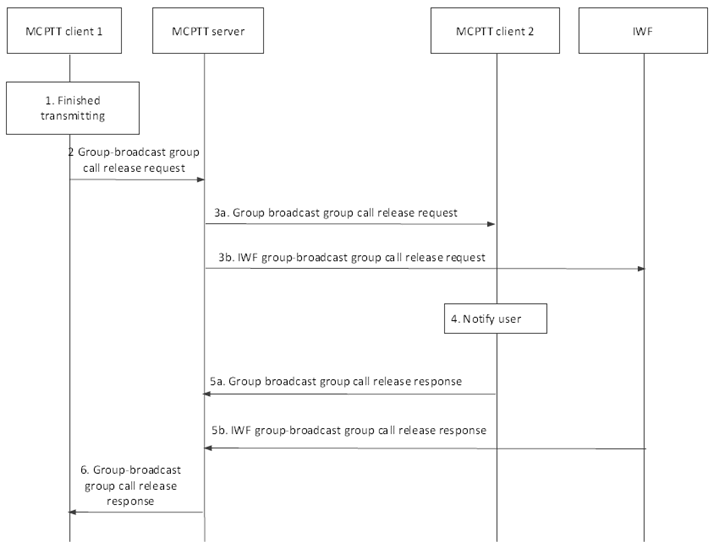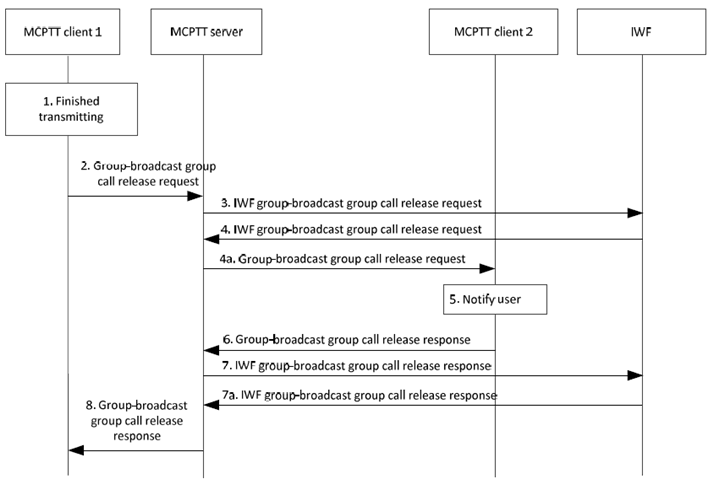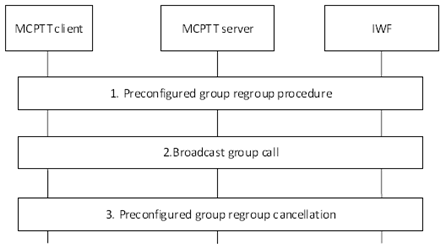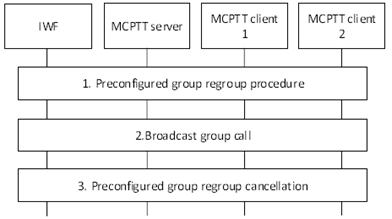Content for TS 23.283 Word version: 18.1.0
1…
10…
10.2…
10.2.2…
10.2.3…
10.3…
10.3.3…
10.3.3.7…
10.3.4…
10.3.4.4…
10.3.5…
10.3.5.8…
10.3.6…
10.3.7…
10.3.7.5…
10.3.8…
10.4…
10.4.4…
10.5…
10.5.7…
10.6…
10.6.2…
10.6.2.3…
10.6.3…
10.6.4…
10.7…
10.8…
10.11…
10.11.4…
10.12…
10.14…
10.15…
10.3.4.4 Group-broadcast group call release with an interworking group procedure where the group-broadcast group is defined in the MCPTT system
10.3.4.5 Group-broadcast group call release with an interworking group procedure where the group-broadcast group is defined in the LMR system
10.3.4.6 Broadcast group regroup call using pre-configured group
10.3.4.6.1 General
10.3.4.6.2 Broadcast group regroup call using pre-configured group the MCPTT system
10.3.4.6.3 Broadcast group regroup call using pre-configured group in the IWF
...
...
10.3.4.4 Group-broadcast group call release with an interworking group procedure where the group-broadcast group is defined in the MCPTT system p. 58
When the call originator has completed transmitting, the group-broadcast group call is ended and the resources are released.
Figure 10.3.4.4-1 illustrates the procedure for group-broadcast group call release (the group-broadcast group is defined in the MCPTT system).
Pre-conditions:
- An on-going group-broadcast group call involving MCPTT client 1, the MCPTT client 2 and the IWF exists.

Figure 10.3.4.4-1: Group-broadcast group call transmission ended (group-broadcast group is defined in the MCPTT system)
(⇒ copy of original 3GPP image)
(⇒ copy of original 3GPP image)
Step 1.
MCPTT user on MCPTT client 1 finished transmitting.
Step 2.
A group-broadcast group call release request is sent to the MCPTT server of the group-broadcast group.
Step 3.
The MCPTT users of MCPTT client 2 and the IWF of the group-broadcast group's subordinate groups are sent a group-broadcast group call release request. If the IWF has affiliated to this group on behalf of the group's LMR users, only one IWF group-broadcast group call release request is sent to the IWF. If the MCPTT server has received individual affiliations from the group's LMR users, an individual IWF group-broadcast group call request is sent (to the IWF) for each affiliated LMR user.
Step 4.
MCPTT client 2 and the IWF notify their users that the group-broadcast group call has ended.
Step 5.
MCPTT client 2 and the IWF respond to confirm the release of the group-broadcast group call by sending a group-broadcast group call release response. If the IWF has affiliated to this group on behalf of the group's LMR users, only one IWF group-broadcast group call release response is sent to the MCPTT server. If the MCPTT server has received individual affiliations from the group's LMR users, an individual IWF group-broadcast group call response is sent (to the MCPTT server) for each affiliated LMR user.
Step 6.
The MCPTT server sends a group-broadcast group call release response indicating to the initiator that the call is now ended.
10.3.4.5 Group-broadcast group call release with an interworking group procedure where the group-broadcast group is defined in the LMR system p. 60
When the call originator has completed transmitting, the group-broadcast group call is ended and the resources are released.
Figure 10.3.4.5-1 illustrates the procedure for group-broadcast group call release (the group-broadcast group defined in the LMR system).
Pre-conditions:
- An on-going group-broadcast group call involving MCPTT client 1, the MCPTT client 2 and the IWF exists.

Figure 10.3.4.5-1: Group-broadcast group call transmission ended (group-broadcast group defined in the LMR system)
(⇒ copy of original 3GPP image)
(⇒ copy of original 3GPP image)
Step 1.
The MCPTT user on MCPTT client 1 finished transmitting.
Step 2.
A group-broadcast group call release request is sent to the MCPTT server.
Step 3.
As the group-broadcast group is defined in the LMR system the MCPTT server sends an IWF group-broadcast group call release request to the IWF.
Step 4.
The IWF sends an IWF group-broadcast group call release request to the MCPTT server hosting client 2. The MCPTT server sends the group-broadcast group call release request to MCPTT client 2.
Step 5.
MCPTT client 2 is notified that the group-broadcast group call has ended.
Step 6.
MCPTT client 2 responds to confirm the release of the group-broadcast group call by sending a group-broadcast group call release response.
Step 7.
The MCPTT server sends an IWF group-broadcast group call release response to the IWF. The IWF becomes aware that MCPTT client 2 has confirmed the group-broadcast group call release and replies with another IWF group-broadcast group call release response back to the MCPTT server to trigger step 8.
Step 8.
The MCPTT server sends a group-broadcast group call release response indicating to the initiator that the group-broadcast group call is now ended.
10.3.4.6 Broadcast group regroup call using pre-configured group |R16| p. 61
10.3.4.6.1 General p. 61
The temporary group created using a pre-configured group can be a broadcast group or a non-broadcast group.
A broadcast group regroup call using pre-configured groups can be achieved by first regrouping users into a pre-configured group regroup, making the broadcast group call on the pre-configured group, and then cancelling the pre-configured group regroup.
10.3.4.6.2 Broadcast group regroup call using pre-configured group the MCPTT system p. 61
The broadcast group regroup call procedure using pre-configured group allows an authorized MCPTT user to initiate a broadcast call to a set of MCPTT groups, which are regrouped only for the duration of the broadcast call. The regroup is cancelled at the end of the broadcast call to prevent users from talking back on the pre-configured group regroup. This procedure requires that the authorized MCPTT user is a group member of at least one of the MCPTT groups included in the regroup operation.
Figure 10.3.4.6.2-1 illustrates the procedure to initiate a broadcast group regroup call using a pre-configured MCPTT regroup group owned by the MCPTT system. For simplicity, no receiving clients are shown.
Pre-conditions:
- The MCPTT client is registered with the MCPTT service.
- The MCPTT group identity and group configuration for the pre-configured group regroup have been pre-configured in the MCPTT client and the IWF. The MCPTT client and the IWF have received the relevant security related information to allow them to communicate in the pre-configured group regroup.
- The MCPTT client is authorized to initiate a pre-configured group regroup using the pre-configured group regroup procedure.
- The MCPTT client is aware of a suitable pre-configured group whose configuration has been pre-configured in the IWF and the MC service UEs of the MCPTT users who will be regrouped.
- The MCPTT client is affiliated to group 1.
- The IWF is affiliated to one or more of MCPTT group 1, 2 or 3.
- The pre-configured group regroup is homed in the MCPTT server.
- The IWF is home to at least one group that's a constituent group of the pre-configured group regroup.

Figure 10.3.4.6.2-1: Broadcast group regroup call using pre-configured group in the MCPTT system
(⇒ copy of original 3GPP image)
(⇒ copy of original 3GPP image)
Step 1.
The authorized user of the MCPTT client initiates the pre-configured group regroup formation procedure using pre-configured groups as specified in subclause 10.3.7.1. MCPTT groups 1, 2, and 3 are regrouped into group 4.
Step 2.
The MCPTT user at the MCPTT client performs the broadcast group call procedure as specified in subclause 10.3.4.
Step 3.
The MCPTT client initiates the pre-configured group regroup cancellation procedure using pre-configured groups as specified in subclause 10.3.7.1.
10.3.4.6.3 Broadcast group regroup call using pre-configured group in the IWF p. 62
The broadcast group regroup call procedure using a pre-configured group allows an IWF user to initiate a broadcast call to a set of MCPTT groups, which are regrouped only for the duration of the broadcast call.
Figure 10.3.4.6.3-1 illustrates the procedure to initiate a broadcast group regroup call using a pre-configured group owned by the IWF.
Pre-conditions:
- MCPTT clients 1 and 2 are registered with the MCPTT service.
- The MCPTT group identity and group configuration for the pre-configured group regroup have been pre-configured in MCPTT clients 1 and 2, and MCPTT clients 1 and 2 have received the relevant security related information to allow them to communicate in the pre-configured group regroup.
- MCPTT client 1 is affiliated to group 1, MCPTT client 2 is affiliated to group 2. Group 3 is used as the pre-configured group regroup.
- The pre-configured group regroup is homed in the IWF.
- The MCPTT server is home to at least one group that's a constituent group of the pre-configured group regroup.

Figure 10.3.4.6.3-1: Broadcast group regroup call using pre-configured group in the IWF
(⇒ copy of original 3GPP image)
(⇒ copy of original 3GPP image)
Step 1.
The IWF initiates the group regroup formation procedure using pre-configured groups as specified in subclause 10.3.7.1. MCPTT groups 1 and 2 are regrouped into group 3.
Step 2.
The IWF performs the broadcast group call procedure as specified in subclause 10.3.4.
Step 3.
The IWF initiates the pre-configured group regroup cancellation procedure using pre-configured groups as specified in subclause 10.3.7.1.